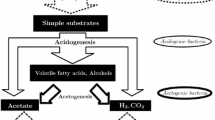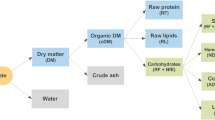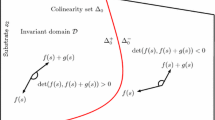Abstract
In this paper, we study the optimization problem of maximizing biogas production at steady state in a two-stage anaerobic digestion model, which was initially proposed in Bernard et al. (Biotechnol Bioeng 75(4):424–438, 2001). Nominal operating points, consisting of steady states where the involved microorganisms coexist, are usually referred to as desired operational conditions, in particular for maximizing biogas production. Nevertheless, we prove that under some conditions related to input substrate concentrations and microorganism biology, characterized by their growth functions, the optimal steady state can be the extinction of one of the two species. We provide some numerical examples of this situation.




Similar content being viewed by others
Notes
Perhaps, because of this fact some authors consider the coexistence (represented by \(E^*_4(u)\)) as a desired operating point. Nevertheless, it could happen that the methane flow rate at \(E^*_2(u)\) (for some u where \(E^*_4(u)\) does not exist) could be greater than the methane flow rate evaluated in any \(E^*_4(u)\) (for u such that \(E^*_4(u)\) exists).
References
Batstone DJ, Keller J, Angelidaki I, Kalyuzhnyi SV, Pavlostathis SG, Rozzi A, Sanders W, Siegrist H, Vavilin VA (2002) The iwa anaerobic digestion model no 1 (adm1). Water Sci Technol 45(10):65–73
Bayen T, Rapaport A, Sebbah M (2014) Minimal time control of the two tanks gradostat model under a cascade inputs constraint. SIAM J Control Optim 52(4):2568–2594
Bayen T, Cots O, Gajardo P (2018) Analysis of an optimal control problem related to the anaerobic digestion process. J Optim Theory Appl 178(2):627–659
Benyahia B, Sari T, Cherki B, Harmand J (2012) Bifurcation and stability analysis of a two step model for monitoring anaerobic digestion processes. J Process Control 22(6):1008–1019
Bernard O, Hadj-Sadok Z, Dochain D, Genovesi A, Steyer JP (2001) Dynamical model development and parameter identification for an anaerobic wastewater treatment process. Biotechnol Bioeng 75(4):424–438
Daoud Y, Abdellatif NN, Harmand J (2017) Modèles mathématiques de digestion anaérobie: effet de l’hydrolyse sur la production du biogaz, https://hal.archives-ouvertes.fr/hal-01562353, working paper or preprint
Donoso-Bravo A, Mailier J, Martin C, Rodríguez J, Aceves-Lara CA, Vande Wouwer A (2011) Model selection, identification and validation in anaerobic digestion: a review. Water Res 45(17):5347–5364
Haddon A, Harmand J, Ramírez H, Rapaport A (2017) Guaranteed value strategy for the optimal control of biogas production in continuous bio-reactors. In: IFAC word congress 2017
Heßeler J, Schmidt JK, Reichl U, Flockerzi D (2006) Coexistence in the chemostat as a result of metabolic by-products. J Math Biol 53(4):556–584
Kelessidis A, Stasinakis AS (2012) Comparative study of the methods used for treatment and final disposal of sewage sludge in European countries. Waste Manag 32(6):1186–1195
Kim M, Ahn YH, Speece R (2002) Comparative process stability and efficiency of anaerobic digestion; mesophilic vs. thermophilic. Water Res 36(17):4369–4385
Novick A, Szilard L (1950) Experiments with the chemostat on spontaneous mutations of bacteria. Proc Natl Acad Sci 36(12):708–719
Sbarciog M, Loccufier M, Vande Wouwer A (2011) On the optimization of biogas production in anaerobic digestion systems. IFAC Proc Vol 44(1):7150–7155
Sbarciog M, Loccufier M, Vande Wouwer A (2012a) An optimizing start-up strategy for a bio-methanator. Bioprocess Biosyst Eng 35(4):565–578
Sbarciog M, Moreno JA, Vande Wouwer A (2012b) A biogas-based switching control policy for anaerobic digestion systems1. IFAC Proc Vol 45(15):603–608
Smith HL, Waltman P (1995) The theory of the chemostat, Cambridge studies in mathematical biology, vol 13. Cambridge University Press, Cambridge; (dynamics of microbial competition)
Weedermann M, Wolkowicz GS, Sasara J (2015) Optimal biogas production in a model for anaerobic digestion. Nonlinear Dyn 81(3):1097–1112
Welz PJ, Holtman G, Haldenwang R, Le Roes-Hill M (2016) Characterisation of winery wastewater from continuous flow settling basins and waste stabilisation ponds over the course of 1 year: implications for biological wastewater treatment and land application. Water Sci Technol 74(9):2036–2050
Acknowledgements
This paper has benefited considerably from advice and comments by Andrés Donoso (CETAQUA, Chile) and Jérôme Harmand (INRA, France), although they should not be held responsible for any mistake. The authors are very grateful to them. We are also grateful to two anonymous reviewers for comments that greatly improved this manuscript. The first author would like to thank INRA Montpellier and the UMR MISTEA for providing a half year delegation during the academic year 2017–2018. This research benefited from the support of FONDECYT grant (Chile) N 1160567 and Proyecto Redes 150011 (Chile). The second author was also partially supported by Basal Project CMM Universidad de Chile.
Author information
Authors and Affiliations
Corresponding author
Appendix: Expressions of curves \(C_1\)–\(C_2\)–\(C_3\) for Monod and Haldane kinetics
Appendix: Expressions of curves \(C_1\)–\(C_2\)–\(C_3\) for Monod and Haldane kinetics
In the AM2 model (Bernard et al. 2001), recall that \({\tilde{\mu }}_1\) and \({\tilde{\mu }}_2\) are Monod and Haldane respectively (see Example 1). We can then explicit the expressions defining the curves \(C_2\) and \(C_3\) given by (23)–(24) as follows. A preliminary inspection allows us to find that for Monod’s kinetics, one has
For Haldane’s kinetics, \(S_2^*(u)\) is the lowest (positive) solution to the equation \({\tilde{\mu }}_2(S_2)=u\). It is easily seen that \(S_2^*(u)\) is the lowest root of a quadratic equation. This gives:
The number \(S_2^*(u)\) is well defined provided that \(u>0\) and \({\varDelta }(u)>0\). In addition, differentiating the previous expression w.r.t. u gives
For the curve \(C_2\), we can then conclude that a point \((S_{in}^1,S_{in}^2)\in C_2\) whenever:
since \({\tilde{\mu }}_2(S_2^*(u))S_2^{* '}(u)=1\). Similarly a point \((S_{in}^1,S_{in}^2)\) belongs to \(C_3\) whenever
These expressions are well defined because one has \({\tilde{\mu }}_1(S_{in}^1)<{\tilde{\mu }}_2({\tilde{S}}_2)\), and they define the curves \(C_2\) and \(C_3\) respectively.
Rights and permissions
About this article
Cite this article
Bayen, T., Gajardo, P. On the steady state optimization of the biogas production in a two-stage anaerobic digestion model. J. Math. Biol. 78, 1067–1087 (2019). https://doi.org/10.1007/s00285-018-1301-3
Received:
Revised:
Published:
Issue Date:
DOI: https://doi.org/10.1007/s00285-018-1301-3




